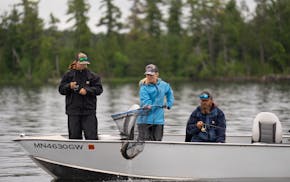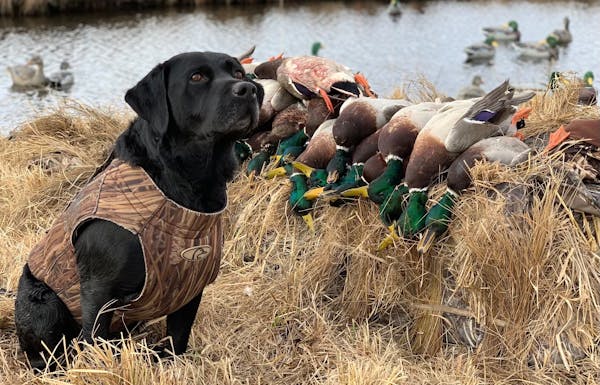LINCOLN COUNTY — Determined people settled in western Minnesota 150 years ago, including in this county, which borders South Dakota. Blizzards, mosquitoes, leaky sod huts and the grasshopper invasion of 1874 were among deterrents to homesteading here, and early residents who weren't tough enough, or stubborn enough, to withstand the discomforts moved on.
Indications are this region's pioneers also bore a healthy distrust of government. Three times during and following the Civil War, the Legislature attempted to name a Minnesota county for President Abraham Lincoln, in 1861, 1866 and 1870, and each time the attempt failed or was ignored by citizens of the counties in question.
Finally, in 1873, Lyon County, whose seat is Marshall, was divided in half and the western portion was named for the nation's 16th president.
The dozen or so scatter gunners I hunted with Saturday, the first day of the Minnesota pheasant season, have over many decades honed a love for this windy, open part of the state, particularly at this time of year.
Ducks migrate now, north to south, through western Minnesota, and pheasants show themselves — assuming in the latter case sufficient boot leather is expended to find these florid birds and put them to wing.
Saturday morning, early, our bunch gathered in the tiny hamlet of Arco, Minn., whose population barely nudges triple digits. Our meeting spot was the Buck Manor, a residence that was purchased by Nick Sovell and others a few years back and, following extensive refurbishment, now serves as the autumnal headquarters for a group that considers prairies the state's true natural wonders.
The bonus is that Buck Manor is outfitted with indoor plumbing, whereas the group's former pheasant hunting headquarters, whose decorative motif I once described as "Early-American Meth Lab," bore only outdoor facilities.
"We call it Buck Manor not because we hunt deer here, although we do," said Sovell, "but because of the many buck euchre games we play here."
Pheasant hunting begins at 9, and our dozen or so hunters broke up into small groups, each traipsing public land on a breezy morning that fortunately didn't see any rain.
On this first walk I joined Sovell and his son Nicholas, as well as Denny Lien, Bob O'Neel, Gary DeAustin and Ken Meyer. We were only a few minutes into this hike on public land when a rooster got up, rising toward the morning's heavy gray skies and rising some more before flying away unscathed, though a few loads of chilled steel chased it.
"Lucky bird," I said.
Last month, the Department of Natural Resources (DNR) released results of its August wildlife roadside counts, reporting that ringneck numbers in western and southwest Minnesota had in some cases doubled from a year ago.
The agency's report didn't go unnoticed. Motels in Marshall and other towns in the western part of the state were in many cases filled with pheasant hunters, and their numbers, we quickly learned Saturday, spilled over to the region's many public hunting areas.
"Hunters are everywhere," Nicholas Sovell said.
Working in our favor was the size of the public parcel we strolled initially. Massive, it used up the first 90 minutes or so of our morning's work, yielding to us a pair of roosters. As a bonus, the seven of us flushed four other cock birds and a like number of hens.
"The number of birds we saw is encouraging," Lien said.
Our next walk, through a state wildlife management area, took less time, and while the cover appeared good and there were no tire tracks on the gravel road surrounding it, indicating it had not been hunted earlier Saturday, we added no birds to our bag.
Noon approached, and deciding our dogs, which included Labradors, golden retrievers and a springer spaniel, needed a break, we headed back to Buck Manor for a lunch of chicken soup, elk chili and sandwiches.
Those of us of a certain age miss on our drives between hunting spots on fall Saturdays the voice of the late Ray Christensen, the Gophers' legendary play-by-play announcer.
To us, the fortunes of the gridiron squad itself were less important than the wagers we would make among ourselves on Ray's intonations, from which we believed we could infer, virtually instantly, whether the Gophers were winning or losing — before we heard the score.
"Gophs are in a hole big time," my friend Willy Smith would say if Ray had his dauber down.
Conversely, if Ray's tone was upbeat, Willy would be, too. "Game's in the bag," he would say. "No worries."
But alas, Ray's been gone some years and, in any event, on Saturday the Gophers weren't playing.
Nevertheless, for us, the day was consummately entertaining.
Tallying our birds at noon, collectively we had a dozen roosters to our credit. A couple more fell to our guns shortly after our midday break, and more still during the same period flushed out of range or took advantage of our errant marksmanship.
On Oct. 21, the South Dakota pheasant season opens and doubtless will offer some good wing-shooting.
But whether it will be any better than the best Minnesota has to offer as the season progresses, and more corn and soybeans are harvested in the state's west and southwest, is debatable, given the encouraging number of birds we saw Saturday.
In fact, had Ray Christensen been doing our play-by-play, his tone would have been cheerful, if not ecstatic.
The day was, in fact, in the bag, with no worries.
Anderson: He paddled solo into the BWCA and didn't come back

Anderson: In early June, Minnesota fish are begging to be caught. Won't you help?





